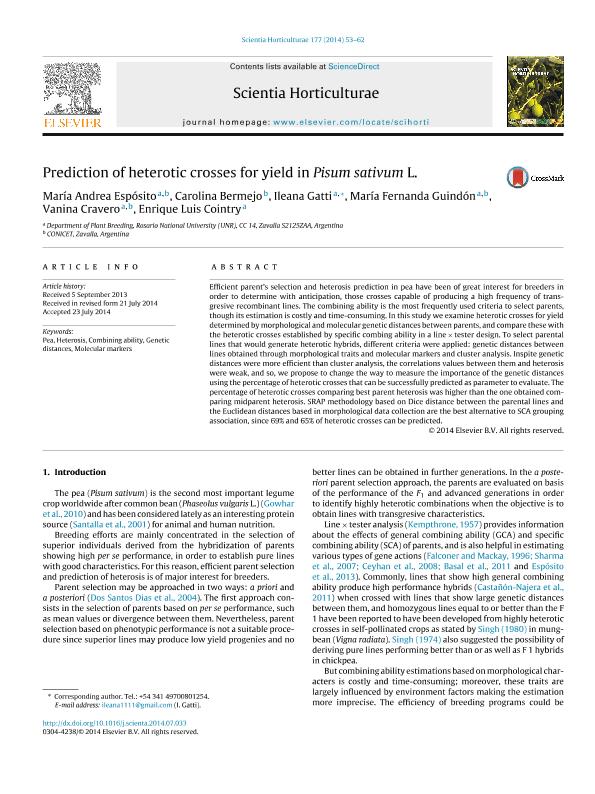Mostrar el registro sencillo del ítem
dc.contributor.author
Espósito, María Andrea

dc.contributor.author
Bermejo, Carolina Julieta

dc.contributor.author
Gatti, Ileana
dc.contributor.author
Guindón, María Fernanda

dc.contributor.author
Cravero, Vanina Pamela

dc.contributor.author
Cointry Peix, Enrique Luis

dc.date.available
2017-12-12T14:04:38Z
dc.date.issued
2014-07
dc.identifier.citation
Espósito, María Andrea; Bermejo, Carolina Julieta; Gatti, Ileana; Guindón, María Fernanda; Cravero, Vanina Pamela; et al.; Prediction of heterotic crosses for yield in Pisum sativum L; Elsevier Science; Scientia Horticulturae; 177; 7-2014; 53-62
dc.identifier.issn
0304-4238
dc.identifier.uri
http://hdl.handle.net/11336/30244
dc.description.abstract
Efficient parent’s selection and heterosis prediction in pea have been of great interest for breeders in order to determine with anticipation, those crosses capable of producing a high frequency of transgresive recombinant lines. The combining ability is the most frequently used criteria to select parents, though its estimation is costly and time-consuming. In this study we examine heterotic crosses for yield determined by morphological and molecular genetic distances between parents, and compare these with the heterotic crosses established by specific combing ability in a line × tester design. To select parental lines that would generate heterotic hybrids, different criteria were applied: genetic distances between lines obtained through morphological traits and molecular markers and cluster analysis. Inspite genetic distances were more efficient than cluster analysis, the correlations values between them and heterosis were weak, and so, we propose to change the way to measure the importance of the genetic distances using the percentage of heterotic crosses that can be successfully predicted as parameter to evaluate. The percentage of heterotic crosses comparing best parent heterosis was higher than the one obtained comparing midparent heterosis. SRAP methodology based on Dice distance between the parental lines and the Euclidean distances based in morphological data collection are the best alternative to SCA grouping association, since 69% and 65% of heterotic crosses can be predicted
dc.format
application/pdf
dc.language.iso
eng
dc.publisher
Elsevier Science

dc.rights
info:eu-repo/semantics/openAccess
dc.rights.uri
https://creativecommons.org/licenses/by-nc-sa/2.5/ar/
dc.subject
Pea
dc.subject
Heterosis
dc.subject
Combining Ability
dc.subject
Genetic Distances
dc.subject
Molecular Markers
dc.subject.classification
Otras Biotecnología Agropecuaria

dc.subject.classification
Biotecnología Agropecuaria

dc.subject.classification
CIENCIAS AGRÍCOLAS

dc.title
Prediction of heterotic crosses for yield in Pisum sativum L
dc.type
info:eu-repo/semantics/article
dc.type
info:ar-repo/semantics/artículo
dc.type
info:eu-repo/semantics/publishedVersion
dc.date.updated
2017-12-11T14:56:22Z
dc.journal.volume
177
dc.journal.pagination
53-62
dc.journal.pais
Países Bajos

dc.journal.ciudad
Amsterdam
dc.description.fil
Fil: Espósito, María Andrea. Universidad Nacional de Rosario; Argentina
dc.description.fil
Fil: Bermejo, Carolina Julieta. Consejo Nacional de Investigaciones Científicas y Técnicas; Argentina
dc.description.fil
Fil: Gatti, Ileana. Universidad Nacional de Rosario; Argentina
dc.description.fil
Fil: Guindón, María Fernanda. Universidad Nacional de Rosario; Argentina. Consejo Nacional de Investigaciones Científicas y Técnicas; Argentina
dc.description.fil
Fil: Cravero, Vanina Pamela. Universidad Nacional de Rosario; Argentina. Consejo Nacional de Investigaciones Científicas y Técnicas; Argentina
dc.description.fil
Fil: Cointry Peix, Enrique Luis. Universidad Nacional de Rosario; Argentina
dc.journal.title
Scientia Horticulturae

dc.relation.alternativeid
info:eu-repo/semantics/altIdentifier/doi/http://dx.doi.org/10.1016/j.scienta.2014.07.033
dc.relation.alternativeid
info:eu-repo/semantics/altIdentifier/url/http://www.sciencedirect.com/science/article/pii/S0304423814004178
Archivos asociados
